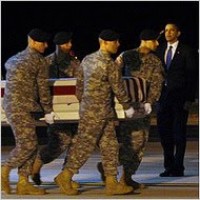Obama’s presence that evening was about perceptions and imagery
Obama: Saluting for the Cameras
By Alan Caruba Friday, October 30, 2009 Presidents engage in all kinds of ceremonial events. Every Thanksgiving, they “pardon” a turkey so it doesn’t end up on the White House menu. They make sure they are photographed with the winning teams of various sporting series. Every Easter they can be found at the White House Egg Roll accompanied, I have always suspected, by a Secret Service agent in a large bunny costume.
Presidents engage in all kinds of ceremonial events. Every Thanksgiving, they “pardon” a turkey so it doesn’t end up on the White House menu. They make sure they are photographed with the winning teams of various sporting series. Every Easter they can be found at the White House Egg Roll accompanied, I have always suspected, by a Secret Service agent in a large bunny costume.
The other evening, shortly after midnight, President Obama made sure to be photographed standing in line with military personnel and some civilians in attendance as the dead, including three drug enforcement agents, from Afghanistan were returned home at Dover Air Force base. Our military casualties are received in a solemn ceremony few except those in attendance ever witness.
Presidents have never participated in this ceremony. The caskets are a too vivid reminder that part of their job is to send troops in harm’s way. President Bush preferred to meet with the families of fallen heroes.
When 241 U.S. military were murdered by a suicide bomber in Beirut on October 23, 1983, President Ronald Reagan attended a ceremony at Camp Lejeune to speak of his grief and anger. Three months after the bombing, he pulled out U.S. troops.
The bombing, authorized by Iran and carried out by Hezbollah, foretold of the way our troops would be attacked by an enemy that would not meet them on the field of battle, would not wear a uniform, and preferred fanatical Islamic self-sacrifice as an instrument of war. The ultimate attack was al Qaeda’s 9/11 against civilians.
President Obama wasn’t there to honor those fallen soldiers or marines. He was there to be seen saluting.
Obama was there because, during the campaign he had used the war in Afghanistan as a way to criticize former President Bush’s decision to depose Iraq’s dictator only to find himself in unforeseen and ill-considered circumstances that required years and a change of strategy to redeem.
Afghanistan, said candidate Obama, was “a war of necessity” whereas Iraq was “a war of choice.” Only now, nine months into his first term, Obama is finding it very difficult to make a choice, to determine the “necessity” of conducting the war in Afghanistan or whether to withdraw from it.
What bothered me, as someone who served in the U.S. Army, was the way Obama was using those returning dead to “send a message” that he was very serious about the decision he was about to make.
The strategy concerning Afghanistan was handed to him by the existing Bush administration in a report prepared for his assumption of the office. His hand-picked general in the field says we will lose without increasing present troop strength.
Obama’s presence that evening was about perceptions and imagery. It was his way of trying to influence public opinion about his failure to act.
Increasingly, questions are being raised about his campaign statements and presumably his commitment to pursue the Taliban and al Qaeda in a vigorous fashion. The enemy knows it and it too is doing what it can to influence public opinion; they have stepped up the killing of American troops.
Frankly, knowing that he had never worn the uniform of his nation, it bothered me that he would stand there in the dark giving a salute. The closest he ever got to wearing a uniform and saluting in his past was when he was in the Boy Scouts—the Indonesian Boy Scouts.
There is something coldly calculating about using the returning battle dead to try to bolster an image of patriotism and commitment to military action, but that is what this President is all about, the image of things, statements about things in which he does not believe and intends to “transform.”
























 An election for President and Commander in Chief of the Military must strive to be above reproach. Our public institutions must give the public confidence that a presidential candidate has complied with the election process that is prescribed by our Constitution and laws. It is only after a presidential candidate satisfies the rules of such a process that he/she can expect members of the public, regardless of their party affiliations, to give him/her the respect that the Office of President so much deserves.
An election for President and Commander in Chief of the Military must strive to be above reproach. Our public institutions must give the public confidence that a presidential candidate has complied with the election process that is prescribed by our Constitution and laws. It is only after a presidential candidate satisfies the rules of such a process that he/she can expect members of the public, regardless of their party affiliations, to give him/her the respect that the Office of President so much deserves.

No comments:
Post a Comment
Note: Only a member of this blog may post a comment.